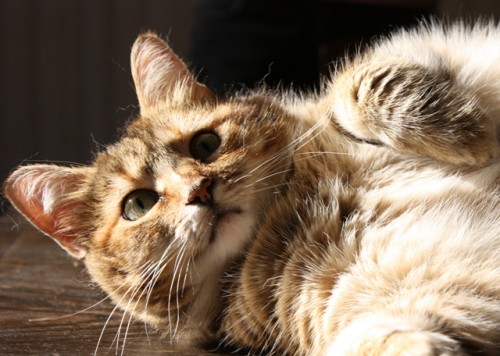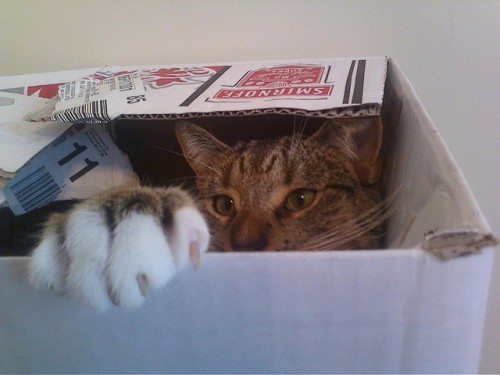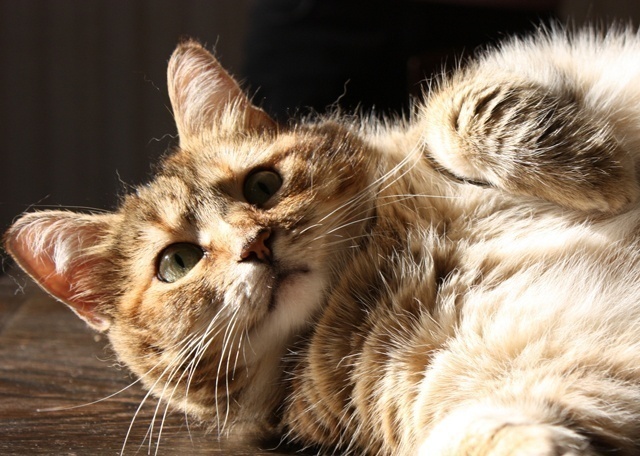A Guide to Feline Obesity
Guest Author: Peter Scully
Cats can be lazy creatures when they find a warm, comfy spot to sleep the day away in. This sounds like a pleasant enough life for any animal, but it can have its drawbacks if it goes too far. Lack of activity can lead cats to gain weight, and obesity can be just as harmful to their health and quality of life as it can be in humans.

Causes and Consequences of Obesity in Cats
The causes of feline obesity are simple enough; too many calories taken in through food compared to too few burned through exercise. It’s no challenge for an owner to reduce their cat’s food intake, but encouraging an animal that doesn’t have to hunt or run from danger can present a greater obstacle. However, it is important to see that the problem is tackled, as obesity can lead to a number of health complications such as diabetes, arthritis, and liver problems. It can also shorten a cats life.
Identifying Feline Obesity
A simple inspection should be enough to give you a fairly decent indication of whether your cat could be overweight. A visual inspection is much easier with short-haired breeds than their long-haired brethren. Your cat’s waistline should be visibly narrower than his ribs, both from the side and when viewed from above.
You should also inspect your cat by feeling around, especially if she is a long-haired breed in which case a visual inspection may be less reliable. You should be able to easily feel her ribs with only a thin layer of fat in between. A cat whose ribs cannot be felt at all is definitely in need of weight loss.
Encouraging Your Cat to Lose Weight
By far the easiest element of a weight loss programme to implement is a controlled diet. However, though it might seem easy to cut back on treats or portion sizes, putting your cat on a weight loss diet is still something to approach with care. Excessively rapid weight loss can carry health complications of its own, notably liver problems, and this can be just as bad as obesity.
The best way to put your pet on a controlled diet is to use a specialist low-calorie food. This will be pre-formulated to facilitate a healthy rate of weight loss while still providing all important nutrients. Make sure you measure the correct portion sizes to avoid cancelling out the benefits by overfeeding.

Cats are notorious for doing what they want, when they want, so encouraging them to exercise is much harder than with other animals. The easiest way to make your pet more active is to make sure that what they want will involve exercise. For example, consider putting their food bowl in a high place so they will have to jump and climb before they can tuck in.
The other great way to encourage your pet to exercise is through play. Chasing laser pointers, rolling around with feathers and jumping to bat at a bauble are all ways to burn calories. It is also possible to incorporate this into mealtimes through food-dispensing toys that only feed your cat when he plays with them.
May this guide to feline obesity help you in getting your cat back to tip-top shape.
Author Bio: Peter Scully writes for Medicines4Pets, an online supplier of prescription and non-prescription medicines for pets.
***
Guide to Feline Obesity, #cats #pethealth Click To Tweet
***
A QUESTION FOR YOU:
Do you have an obese pet? What steps are you taking?
***
***
*** Leave a comment below and remember to share. ***
It’s just sexy!
As always, thank you for taking the time to visit my blog!

♥ PEACE ♥
- 4 Tips for Maintaining Healthy Weight for Your Cat - December 20, 2019
- 8 Amazing Benefits of CBD for Dogs and Other Pets - December 12, 2019
- Kibble or Canned Pet Food? What Should Your Pet Be Eating? - December 9, 2019



I have 3 cats, one of them which is male is truly obese. SO I just started some physical activities and play for him.
Good for you, Tom. Thanks for stopping by!
I have 4 cats with one being 18 lbs. What I decided to do was put them all on wet food only and the big boy on a lower calorie food (I am using the Wellness chicken pate) the other 3 are getting Natures Valley and sometimes Tiki Cat chicken. I just started this because I noticed the big boy limping a bit.
I thought maybe arthritis but I would rather get his weight in check first. I’ll probably do a write up as he changes month to month. Thanks for the post!
Great post. I have 2 cats that are truly obese. I need to try to get them to play more and eat less.
Hey, Ellen. Thanks for your comment. I know how difficult it can be when you have an overweight pet. We tend to feel that we’re depriving them if we start to feed them less. 🙂 I suppose it must be the same with children, although I wouldn’t know. All the best to you and your kitties.